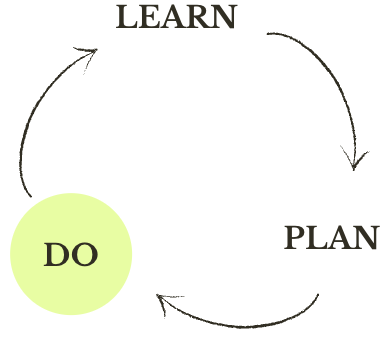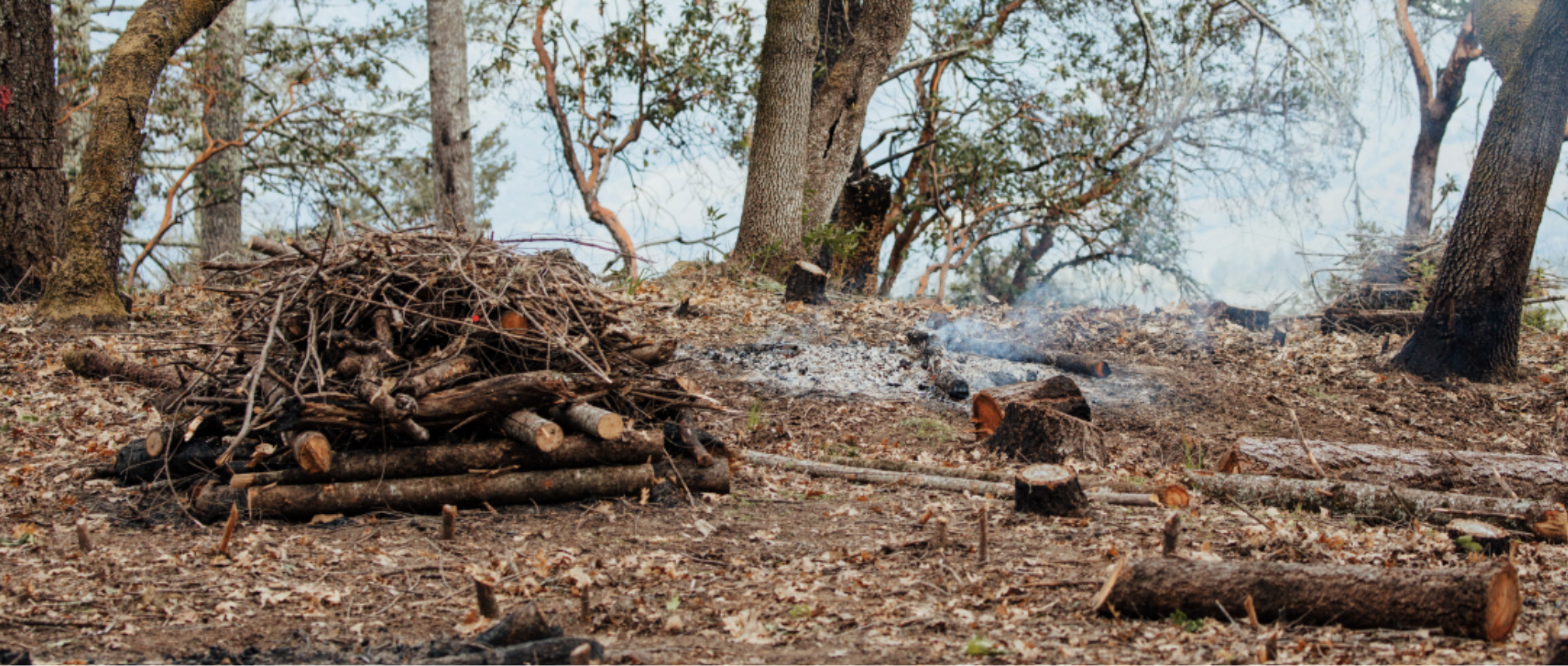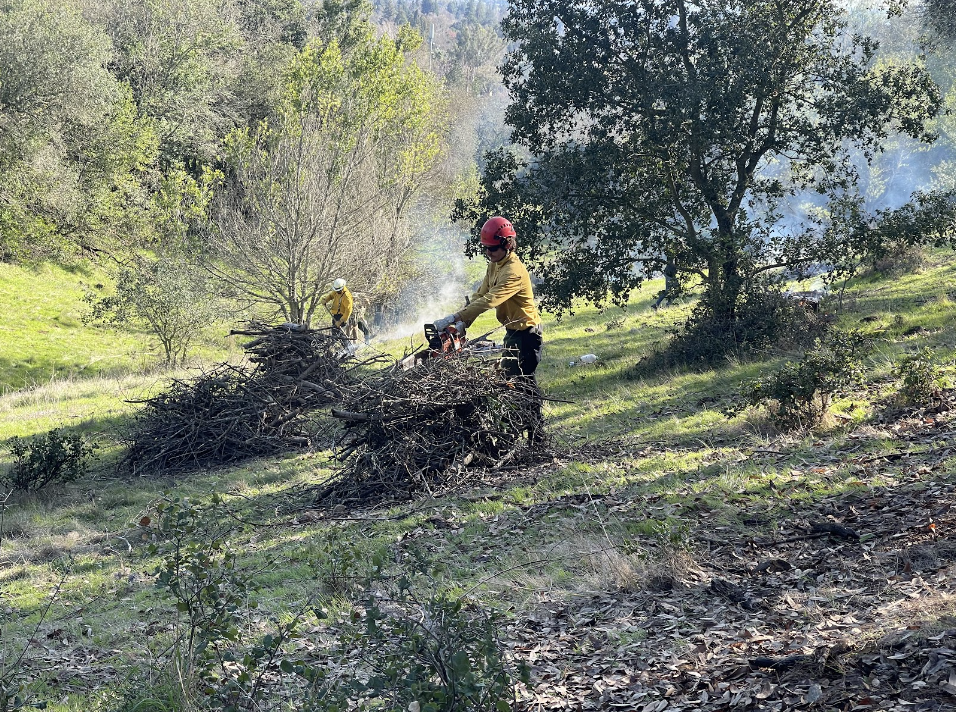DO THE WORK
Pile Burning
Pile burning is the strategic building and burning piles of woody material to reduce the amount of flammable material in an area. The woody material might come from vegetation management activities, storms, or the natural aging of the land. Pile burning is one of several options for Managing Woody Material.


Photo: Jameson Wolf.
Benefits
Pile burning is often the most cost-effective and efficient way to manage flammable material on the land. This practice removes flammable woody material or fuels, recycles nutrients back into soil, and
Many land managers use Thinning combined with pile burning as a strategy to prepare a site with high levels of flammable material for future Beneficial Fire.
When and Where to Use a Burn Pile
Woody materials or fuels naturally expand wherever there is vegetation, but can increase with stewardship activities. It’s important to reduce these fuels for wildfire resilience.
Burn Piles can be used anywhere excess woody slash is creating increased wildfire risk, although it is not recommended on steep slopes, due to the risk of burning logs or embers rolling downhill and igniting other vegetation.

Photo: Sonoma Ecology Center.
Key Points Before Proceeding
Burning residential piles requires a permit and is typically allowed from November 1 to May 1. These dates change based on each year’s timing of wildfire season. Always check for details at CAL FIRE’s Burn Permit site. Determine if you are in State Responsibility Area (SRA), Local Responsibility Area (LRA), or both. Contact your local fire district or CAL FIRE to find out.
- If in the SRA, you will need a burn permit from CAL FIRE (in addition to an air quality permit) only if burning between May 1 until the end of the fall fire season (October or November). The permits are free and informative. Four foot by four foot piles or smaller require a LE-62a permit.
- In the SRA, piles larger than four feet by four feet require an LE-5 permit. This is generally for very large piles such as logging slash piles.
- If you are in the LRA, check with your city or county fire district to get a burn permit.
Avoid placing burn piles on valuable native plants (such as perennial grasses), under trees with low hanging branches, under power lines, or near structures. Materials greater than 12 inches in diameter do not easily burn; instead consider using them for Retaining & Creating Habitat Features, or firewood.
Since burning a pile with trees overhead can damage the canopy, it can be difficult to find open areas to create burn piles in continuous forest or woodland. In these cases, Lop & Scatter can also be used as an alternative, or piles can be placed and built so there is spacing three times the height of the pile between the top of the pile and the lowest branches of surrounding trees and bushes.
Invasive species, especially thistles, are often among the first plants that take over “burn scars,” the patches of soil and ashes left after piles are burnt. Planting native grass seeds or seed plugs in these areas prevents invasive species from growing in while creating a seed source for native species.
If your piles have been sitting around for a few months, be sure to jostle them or kick them with your boot before you begin burning. This will allow wildlife–birds, salamanders, woodrats, or lizards– who have made a home in the pile to scatter.
How to Create and Extinguish a Burn Pile
This guide to pile burning—co-written by Sonoma County’s fire practitioners and experts—offers excellent guidance on the practice from start to finish, including permitting.
Variations on this Practice
Making and Using Biochar is a great way to reduce the air pollution and greenhouse gas emissions from pile burning while creating a form of charcoal that sequesters carbon in the soil.
Rather than burning all materials, consider building and retaining Wildlife Habitat Brush Piles or other habitat features.
Timing Considerations
- Burning is permitted during “winter preparedness” season, which typically runs from November 1 to May 1, but these dates are variable. Always check for details at CAL FIRE’s Burn Permit site.
- This practice is best done outside of the bird nesting season, generally from March through August in Sonoma County. This timeframe covers nesting season for the majority of songbirds and raptors (birds of prey). If the work is done during nesting season, consider first conducting Nesting Bird Surveys. Surveying over a longer period can protect more types of birds. For example, the Northern Spotted Owl can begin nesting as early as January in Sonoma County.
Equipment
Personal Protective Equipment (PPE)
- Long pants and a long sleeve shirt made of non-synthetic/natural materials (i.e. cotton or wool) that are naturally fire-resistant
- “Vibram” soled boots
- Helmet
- Eye protection
- Ear protection
Tools
- Hand saw
- Pruner and/or loppers
- Chainsaw for building piles
- Pole saws or a ladder to use with hand tools
- Matches, lighter, propane torch or other fire lighting equipment
- Shovels during burning
- Metal rake for moving ashes.
- Consider a backpack water pump or sprayer for larger projects
Maintenance
Consider planting small plugs of locally native grass species into the burned area to speed recovery of the burn area. A good choice for grassy or savannah areas is purple needlegrass (Stipa pulchra); for forests with partial shade, consider California fescue (Festuca californica).

[NOTE: this photo is very lo res]
Photo: Pepperwood.
Related Practices
Retaining and Creating Habitat Features
Managing Roads and Trails (coming soon)
Please note: this is a general guide. The specifics of how and when to do this practice will depend on many factors, including the site’s particular vegetation, climate and topography, history, and land management goals. Always consult with a professional if you’re unsure.
Do you have your principles in mind? Remember to regularly check in with your land management values and intended outcomes, to assure your practices and actions will actually achieve your goals.
Additional Resources
Excellent, local, current Tips for Building and Extinguishing a Burn Pile in Sonoma County.
Sonoma County’s regulations page for pile burning in the rainy season.
CAL FIRE’s instructions for burn permits.
Our local prescribed burn association, Good Fire Alliance, offers hands-on opportunities to learn about controlled burns in our area. To join their listserv, sign up for collective burns, volunteer days, and classes, email main+subscribe@gfa.groups.io.
UCCE produced an excellent series of videos on “Pile Burning Fundamentals.” Email Tori Norville, UCCE Fire Science Advisor, at trnorville@ucanr.edu, to set up a free site visit. To get announcements about pile burning classes and grants, subscribe to a newsletter here.
Pepperwood hosts pile burning workshops. Visit their classes page to check for availability and to sign up.


